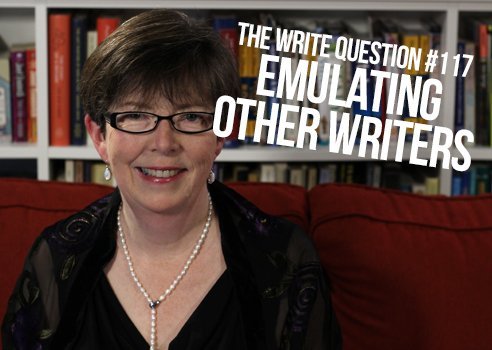Viewing time: 4 mins. 14 secs.
The Write Question is a weekly video podcast about writing that I started in 2017 and that ran, more or less weekly, until April 2022. This is a republication of issue #117, which discusses how to emulate other writers you admire. The post first ran on Nov. 22/19.
Transcript:
Do you want to learn how to emulate other, successful writers? That’s the topic I’m addressing today in The Write Question. I’m Daphne Gray-Grant, the Publication Coach.
I have a question from Melissa Johnson, a writer based in Worthington, Ohio. Here’s what she’s asked via email:
“When I think of writers that I’d like to emulate, I find it hard to put my finger on what they do that works. Do you have a list of questions that you ask yourself about another writer’s style that brings out what you appreciate in it?”
Thanks for the question, Melissa. I think it’s fascinating to reflect on why we so appreciate certain types of art — and certain artists. Are you an Ella Fitzgerald fan? Or are you more interested in Lady Gaga?
What about the painting of Miro vs the painting of Andy Warhol? And which dancer do you prefer: Michael Jackson or Mikhail Baryshnikov?
The thing about taste is it’s personal. And that’s just as true of writing as it is of the other arts.
I’m a person who has strong feelings about the writers I really like. If I’m a fan of someone, I’m all in. Writers who fall on that list for me include: Salley Vickers, Colum McCann and Dominic Smith. I bet you don’t even know some of those names! That’s because they’re people who aren’t household words. I just like their writing. See below for links to their books I especially appreciated.
Now, I’m not a fiction writer myself, so I’m not trying to write like these novelists. But if I were, I know what I’d do. I’d start to copy them, word for word. In fact, I’ve copied non-fiction writers and it’s taught me a lot.
The act of copying someone and then re-reading the work you’ve copied can lead to some remarkable insights. In my own case, I revised my views about how to manage quotes from people I’ve interviewed. See below for a link to my blog post on being a copycat. I also write about this experience on page 43 of my new book, Your Happy First Daft.
It can be really challenging to get to the root of why we like certain pieces of art. But as you copy the work of your favourite writers, you might consider some of the following issues:
- Vocabulary – does your writer use long words or short ones? And are they mostly concrete or mostly abstract?
- Sentence length – how long are their typical sentences? Do they tend toward the shortish range (14-16 words) or are they, on average, longer?
- What sorts of verbs do they use? Are they colourful and specific ones? Or are state-of-being verbs like is and has?
- What sorts of connectors and transitions do they use? A basic vocabulary of connectors — words such as because, consequently and in short — can help readers glide through a piece of text.
- Do they use figurative language? Metaphors, similes, personification and hyperbole can make writing richer, deeper, more interesting.
On the other hand, don’t get too jammed up by analysis. Sometimes it’s hard to understand the mechanics of art and it’s better just to let yourself fall into appreciation.
Finally, let me wrap up with a quote from dancer Twyla Tharp: “Art is the only way to run away without leaving home.”
Melissa, there is an element of writing that is hard to pin down. It’s transcendent and ineffable. But read enough of it and your own writing will improve, even if you don’t entirely understand how or why.
Links
Miss Garnett’s Angel by Salley Vickers
13 Ways of Looking by Colum McCann
The Last Painting of Sara De Vos by Dominic Smith
Your Happy First Draft by Daphne Gray-Grant


